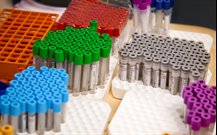Epidemiology and Biobanks
Research areas

Protocol Publications
- Protocols
Image

Identifying placebo responders and predictors of response in osteoarthritis: a protocol for individual patient data meta-analysis. Further information
Im

age
Relative efficacy of topical non-steroidal anti-inflammatory drugs and topical capsaicin in osteoarthritis: protocol for an individual patient data meta-analysis. Further information
Introduction
Understanding the key factors associated with and predicting pain in arthritis is essential in order to better identify those at high risk, to inform treatment choices, and to develop preventative and treatment strategies to reduce the burden of arthritis pain in society.
Genetic and biomarker studies can identify molecular pathways that contribute to arthritis pain, and help us to understand how individuals respond to different treatments. Our extensive collections of data, biofluids and tissues provide a key resource to address these research questions.
Research areas
Epidemiological studies
We have established a large questionnaire database of over 9,000 community-derived people comprising the Knee Pain in the Community (KPIC) cohort. This study will determine the natural history of knee pain and knee osteoarthritis and the reasons why some individuals develop severe pain and others do not. All participants are invited to fill in questionnaires about knee pain and pain elsewhere that they experience and other aspects of their health and wellbeing. A group of people in KPIC (200) who have developed knee pain within the last 3 years are helping us to find out how their pain changes with time, and how this might be caused by changes in the joint and brain.
In this and other community-based cross-sectional and longitudinal studies we have extensive phenotypic characterisation of participants, including: age of symptom onset; the distribution of pain and joint changes throughout the body; detailed self-reported lifestyle factors; and co-morbidities. Radiographs and knee ultrasound, pain pressure thresholds, muscle function and gait recording is performed on a sample of participants (400).
Through these studies we are investigating the incidence, prevalence, natural history and impact of joint pain. We explore risk factors for the development and progression of arthritis pain, in both osteoarthritis and rheumatoid arthritis. We are identifying features that might help explain differences in pain severity and treatment responses between individuals, and that might help us to identify those groups of people for whom changing their treatment might be particularly helpful.
Biobanks
We have established respositories of blood, urine, DNA, synovial fluid and joint tissues linked to clinical data used in epidemiological studies. Our joint tissue repository currently contains samples from >2,500 cases who have undergone total joint replacement, and >200 post mortem cases (>400 knees). These repositories are being used to investigate molecular and structural changes within the knees in arthritis, to identify biomarkers for arthritis and pain, and for genetic association and gene-environmental interaction studies. We are currently examining the genetic associations of pain in relation to knee and hip OA, comparing pain gene polymorphisms in symptomatic versus asymptomatic OA, and in people who have persistent pain following total joint replacement.
[Back to top]